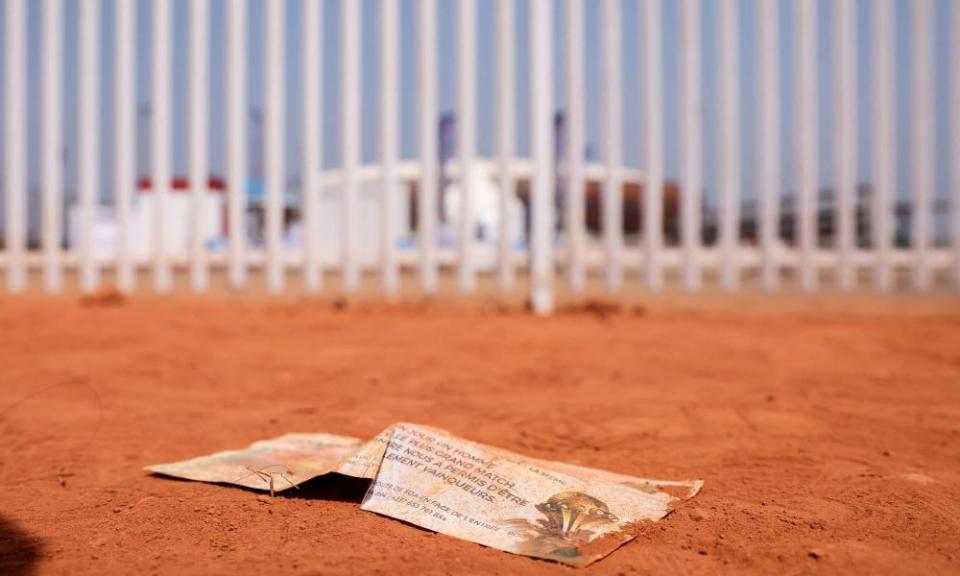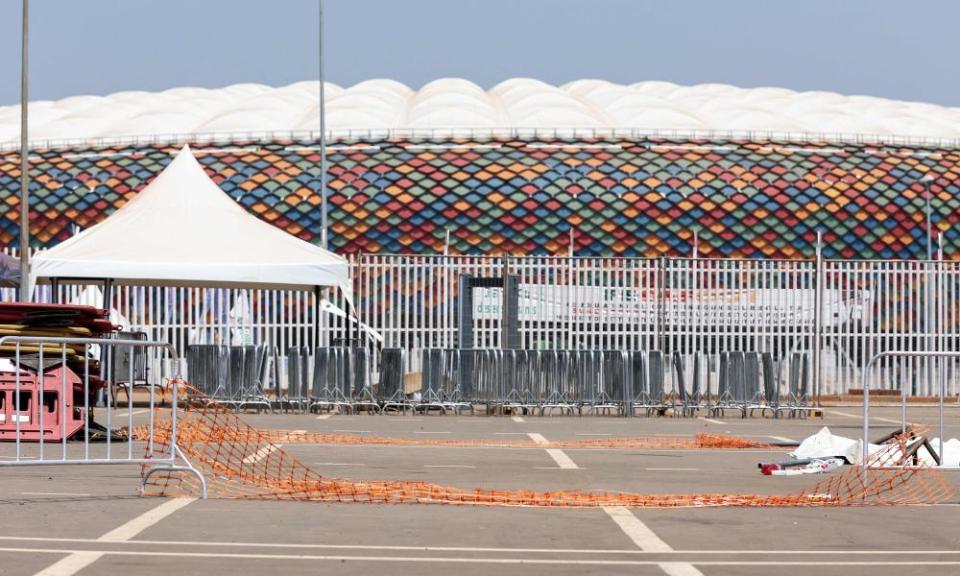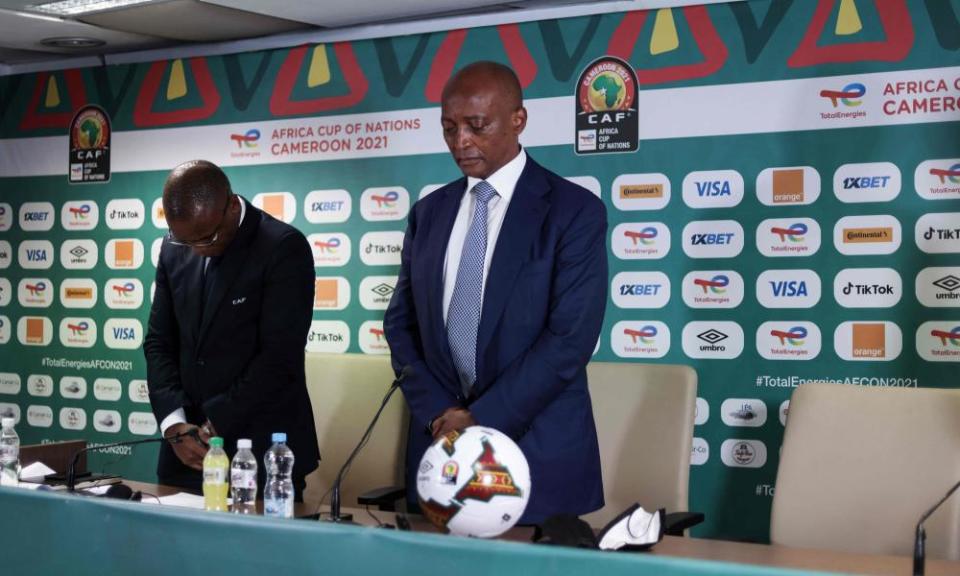‘Why did people have to die?’: Cameroon mourns after stadium tragedy

Supporters and survivors talk of the chaotic scenes that left eight dead after a crush outside the Olembe Stadium
About 150 yards from the turnstiles at the Olembe Stadium stands a plain white-painted metal fence. There are Vs at the top of the posts for the addition of barbed wire, but none has been added. There are three gates in the fence, but only the left-hand one was open on Monday night. Separating it from the central gate was a temporary barrier. On Tuesday, it lay flat, buckled over a kerb by the side of a road, flattened by thousands of feet. It was there, during Cameroon’s Africa Cup of Nations last-16 victory over Comoros, that eight people died and a further 38 were injured.
Related: Eight killed after crush outside Africa Cup of Nations match in Cameroon
An attempt has been made to clear up but inside the left-hand gate and on the avenue leading up to the South Stand, debris remains. There are shards of broken vuvuzelas, a sandal and a shoe, a pair of broken sunglasses and the shattered lens from another. An advertising banner lies twisted on the dusty concrete, wrenched in the chaos from its kiosk. Eyewitnesses say that, as they left the game on Monday, there were dozens of shoes and broken vuvuzelas in this area.
It appears that several thousand fans approached the stadium from the south and were funnelled up a broad avenue towards Covid-testing tents and security checks. About 20 yards beyond security, across the road, is the fence. It seems that in the minutes leading up to kick-off, at 8pm, the area became crowded and fans began to push towards the open left-hand gate.
“There were only 10 or 20 police officers for about 1,000 people – it was not enough,” said Romaric, a fan who attended the match with his fiancee. “I clearly heard one of them say that the stand was full, that they should start locking the gates.”
That was at 7.50pm and, with the bottleneck building, officers began advising fans to walk to the less busy entrances on other sides of the ground. “Policemen were telling everyone that other gates were open but many wanted to take the shortest route rather than go round,” Romaric said. “We kept moving and walked to the entrance that was the most free.”

Video footage shows fans climbing the fence even then, even if the area does not seem unduly full. But at kick-off there was a surge, crushing fans against the fence, although doctors at the Centre des Urgences de Yaoundé (Cury) said most of the injuries they had seen had been caused by fans being trampled upon.
“Everybody wanted to get into the match and it caused people to start forcing their way in, treading over others,” said Dr Diana Bikele, one of the medics at Cury. She and her colleagues treated four severely injured patients and two who were moderately hurt. The casualties had initially been taken to the Messassi hospital, a few minutes from Olembe, but by 4am most had been moved to specialist facilities such as Cury.
Few inside the stadium realised anything untoward had happened. Romaric joined everyone else in watching Cameroon edge through, departing soon after Vincent Aboubakar scored their second goal in the 70th minute. “We went out and realised there were a lot of people covered in dust, as if they’d been in an accident,” he said.
He was told people had died. The Guardian has seen photographs of seven of the eight who lost their lives. At least two were women and at least two children. One was said to be 14; the other looked a lot younger. Footprints are clearly visible on the vest of one man.
“I asked one woman who had dirt all over her body: ‘What happened? Why did people have to die?’” Romaric said. “She told me: ‘People were pushing each other, pushing everywhere trying to enter.’ Some fell and were trampled on; that’s how some of them died on the spot and others were injured.”
The fence was not there three months ago but, along with the road behind the security tents, was part of the infrastructure added in late November after the Confederation of African Football (Caf) threatened to move games from Olembe. Tragically, the decision to install it appears to have been a key factor among several that caused the disaster.
“Some of the people came just to be part of the atmosphere,” the president of Caf, Patrice Motsepe, said in a hastily convened press conference on Tuesday. “Including those who didn’t have tickets, so I think we do accept that thousands of people more than what was expected did arrive.”
He acknowledged that a gate “was closed for inexplicable reasons. If that gate was open as it was supposed to, we wouldn’t have had this problem we have now, this loss of life.”
Covid restrictions mean the stadiums are only supposed to be 80% full for games featuring the hosts but with fans not allocated to specific parts of the ground, let alone specific seats, the south end, nearest the centre of town, was dangerously full. “When the second goal went in and everybody was celebrating, I saw one person near me who was almost dead,” said Francis, a salesman for a print company.
That may or may not have been the 20-year-old male who was admitted to Cury on Monday night. Sitting up in his hospital bed the following afternoon, he said he remembered falling and feeling “a pressure on my chest” after Aboubakar’s goal. He was unconscious at the triage centre at the stadium for between 45 minutes and an hour before being sent to Cury. On Tuesday afternoon, he was one of only two from the initial half-dozen admissions not to have been discharged.

To his right lay Salomon, who required a number of tests and received intravenous treatment after being caught in the crush. “I went to support my team, the game had started there were many fans at the gate and they surged,” he said. “I fell down, just like that, and people trampled over me.”
There are suggestions that an incident like this had only narrowly been averted during at least one of the three group-stage games played at Olembe. One eyewitness at Cameroon’s draw with Cape Verde said security personnel had appeared to lose control there, with the stands eventually becoming hazardously packed in places.
Sunday’s quarter-final between the winners of Wednesday’s Ivory Coast v Egypt tie and Morocco has been moved from Olembe to the Ahmadou Ahidjo Stadium in Yaoundé. Although renovated in 2016, that is a creaking old ground with a capacity of 42,000 and harbours its own question marks. Its gates were shut early at an Africa Women’s Cup of Nations match six years ago, with fans reporting being trampled on in the resulting crush.
On that occasion the consequences were less serious. Sunday’s fixture is unlikely to pose major problems but a semi-final and final involving Cameroon are a different matter. It remains to be seen whether Olembe, with its 60,000 capacity, can be made safe for those games. Another alternative venue, the Japoma Stadium in Douala, has significant problems with its pitch and is unlikely to take any extra workload.
“There must be a committee that’s set up to immediately investigate what happened and in that context to find out who was supposed to do what and who did not do and perform their responsibilities,” said Motsepe. “We want that report by Friday. My duty is always to not just take responsible steps but also I am more inclined to be as conservative as possible to put measures in place that minimises the loss of life.”
The Cup of Nations will go on, and both Caf and the local organisers have significant questions to answer. The Olembe Stadium was built at a reported cost of about $300m (£222m) and was supposed to be the centrepiece of a tournament Cameroon has been waiting to host again for 50 years. Inside it is magnificent, but for now it stands as a vast cenotaph to the eight fans. The broken vuvuzelas may be swept up, but the memories will not be.

